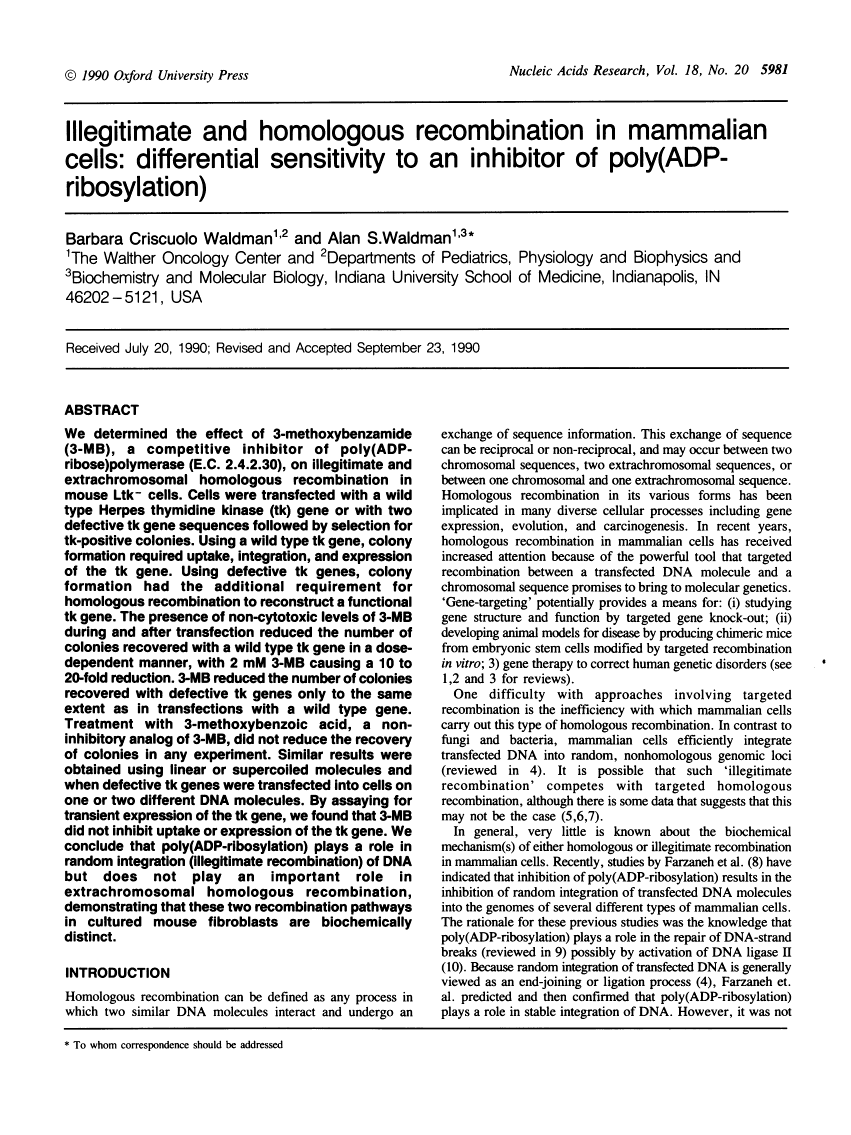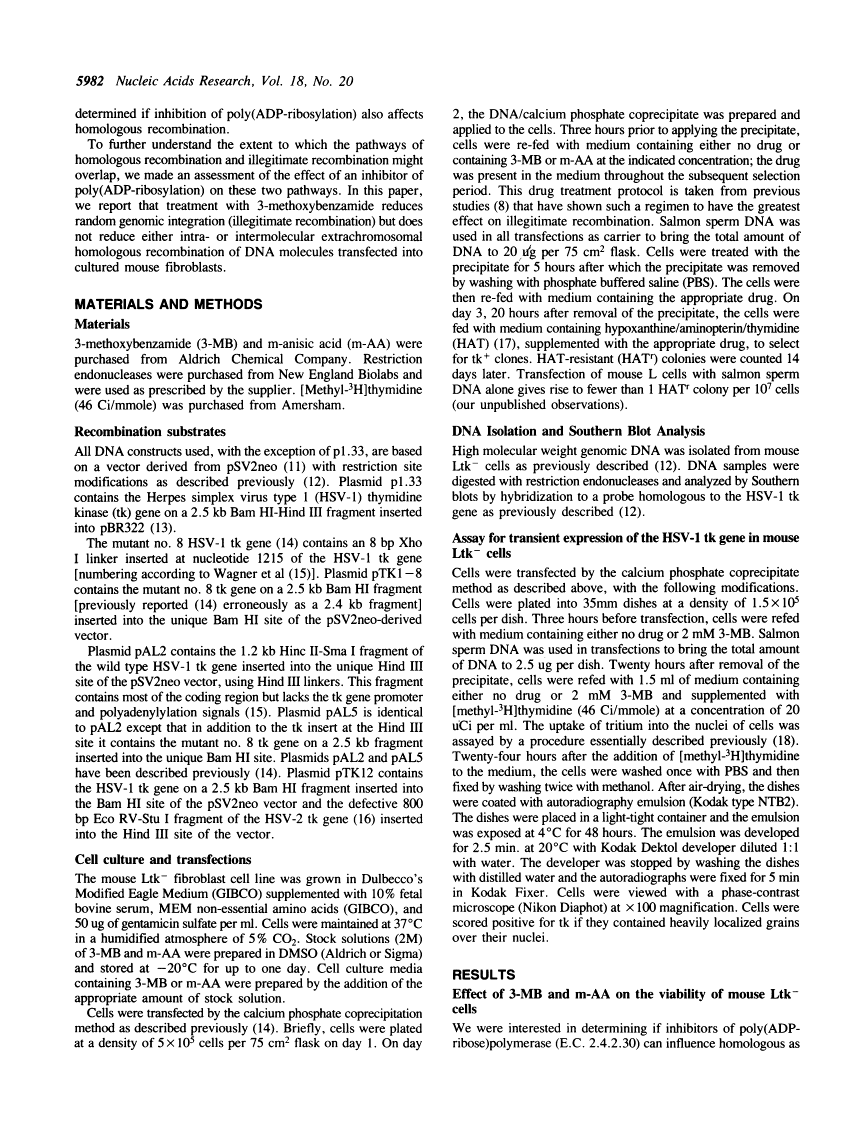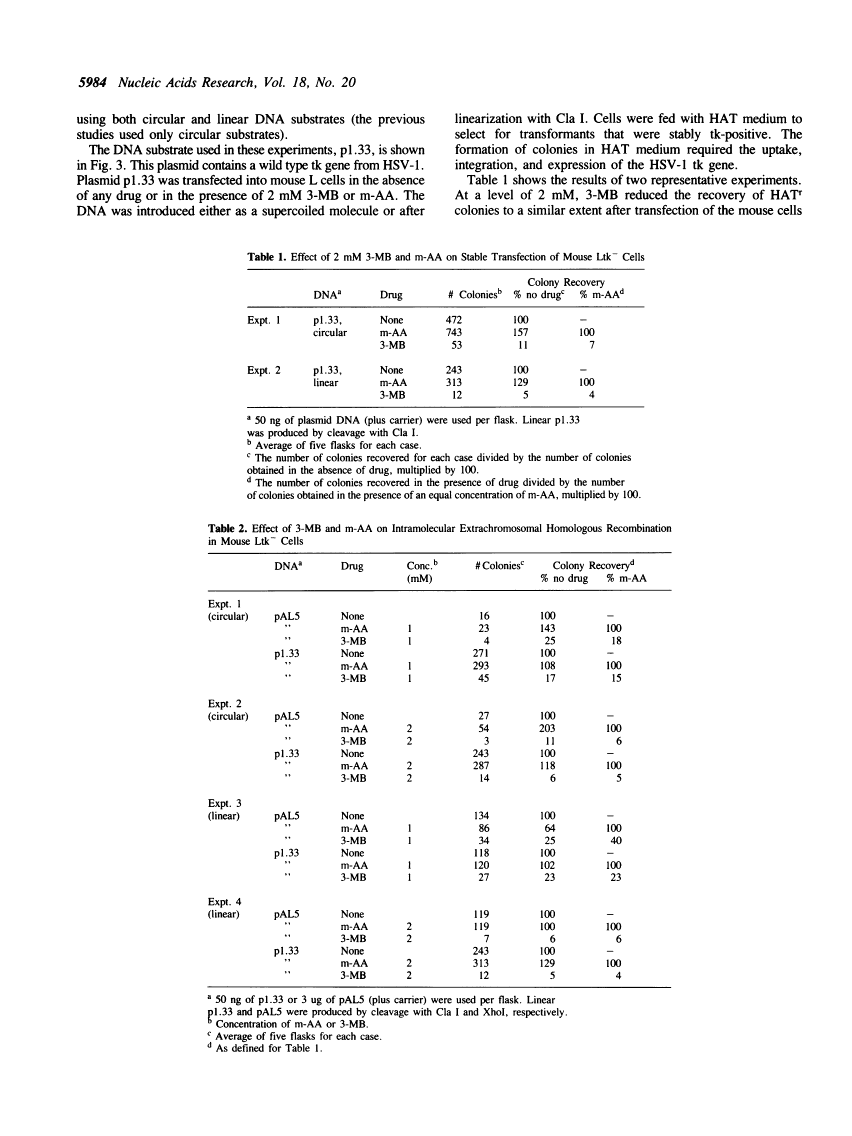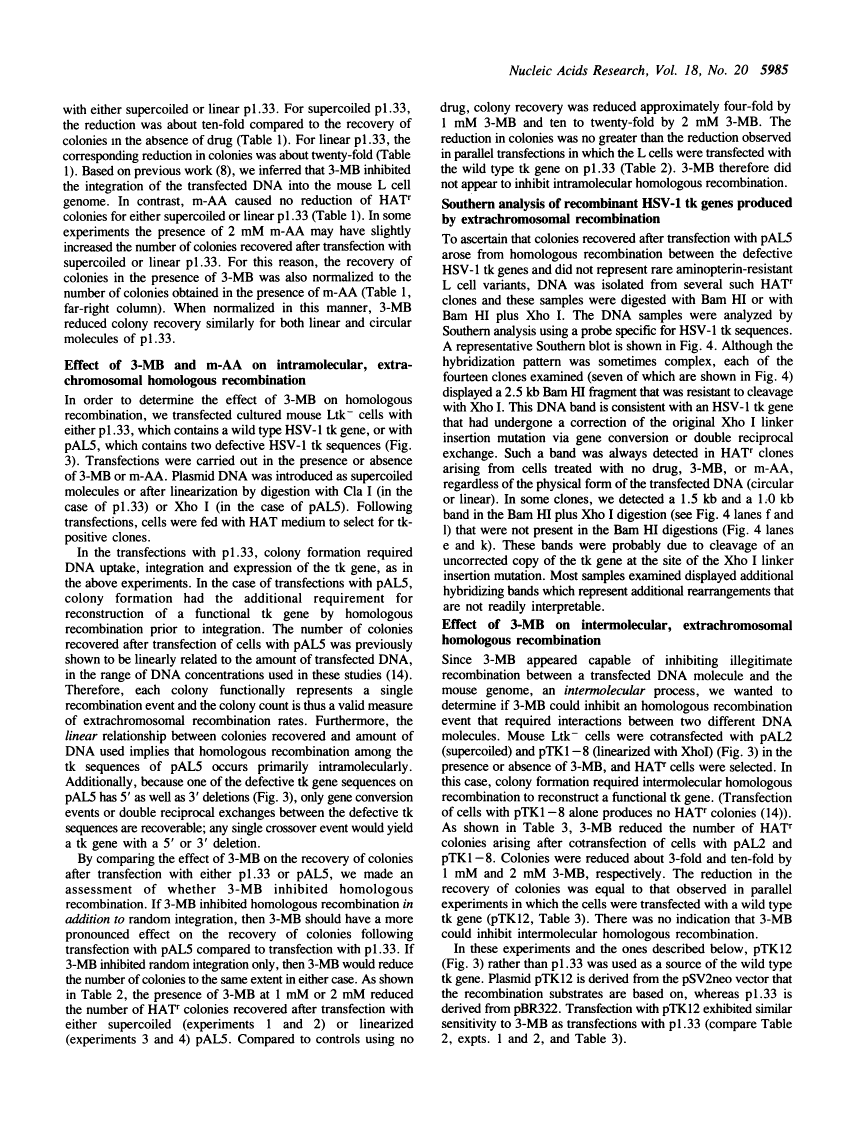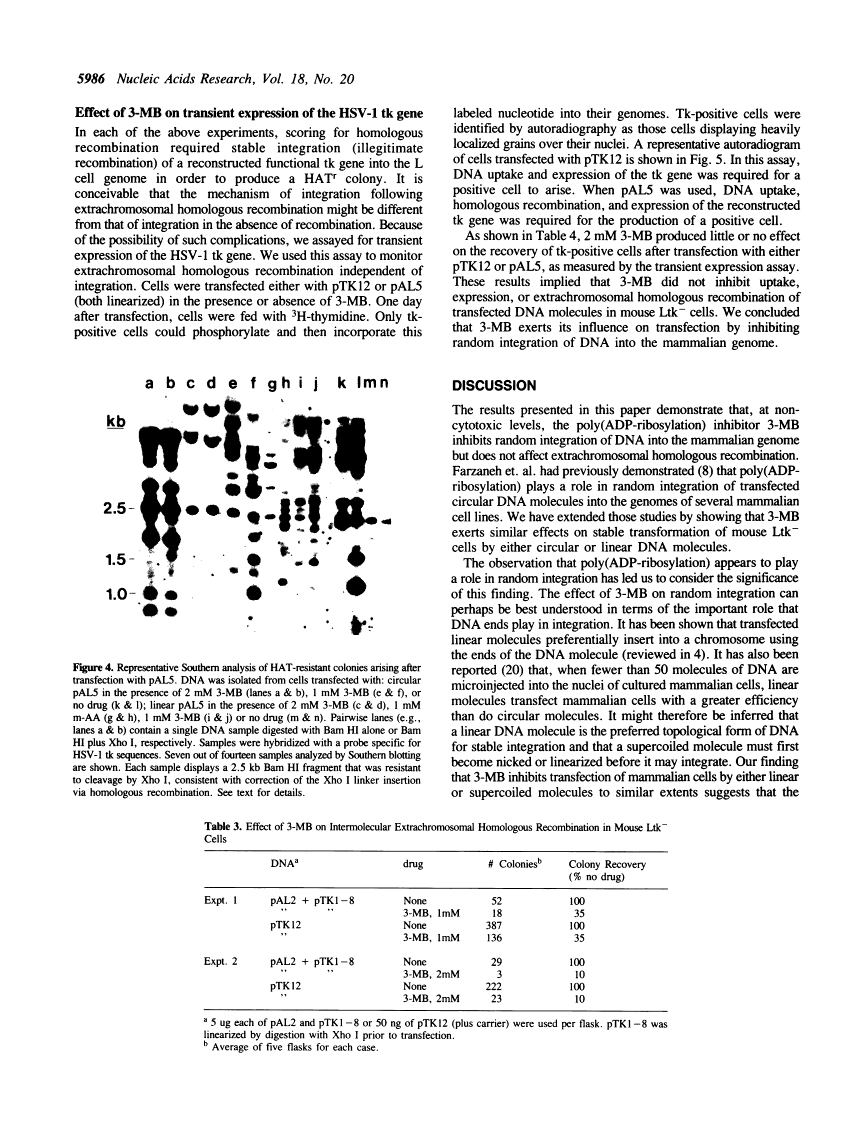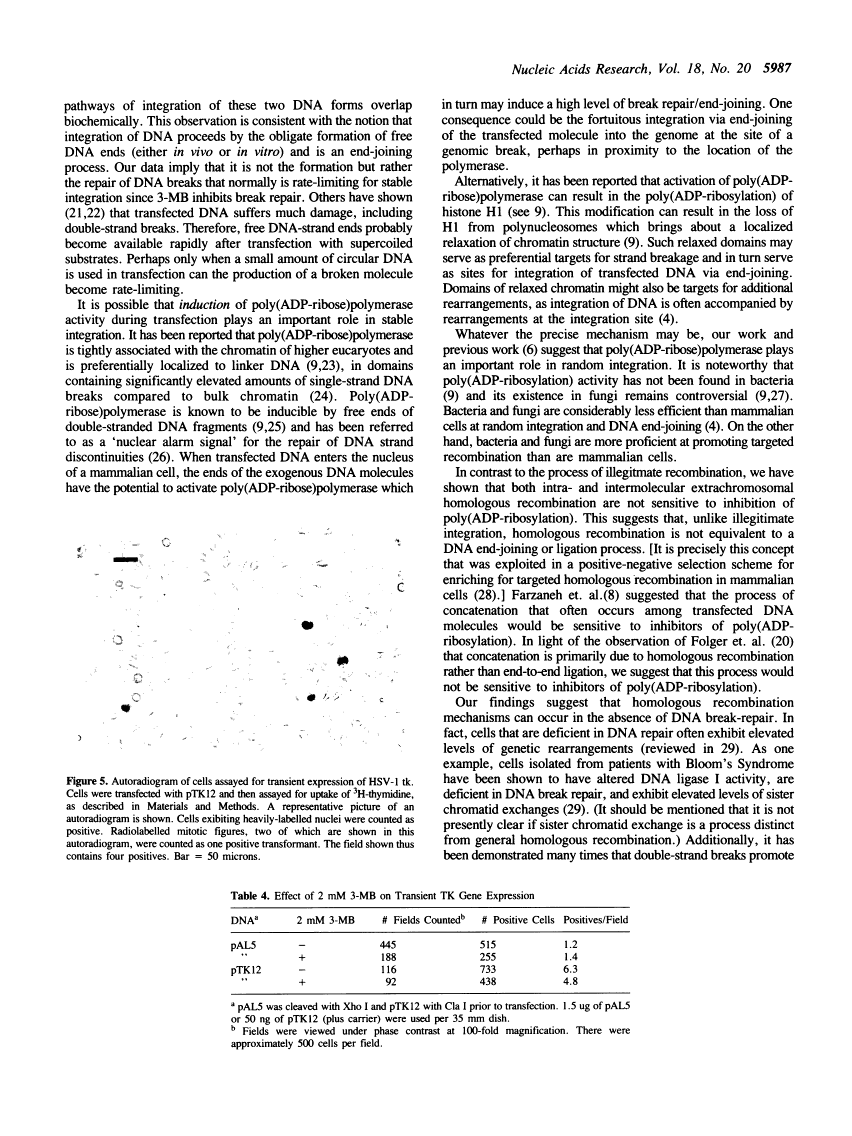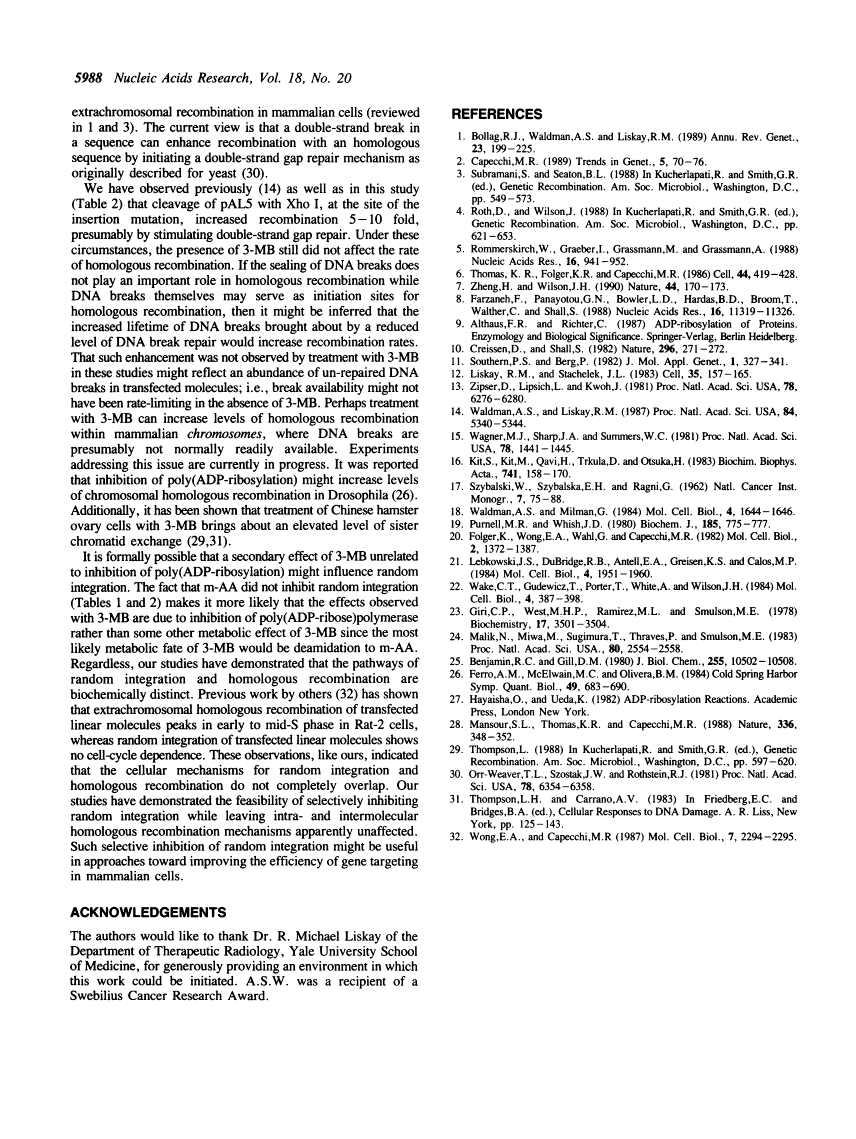Abstract
Free full text

Illegitimate and homologous recombination in mammalian cells: differential sensitivity to an inhibitor of poly(ADP-ribosylation).
Abstract
We determined the effect of 3-methoxybenzamide (3-MB), a competitive inhibitor of poly(ADP-ribose)polymerase (E.C. 2.4.2.30), on illegitimate and extrachromosomal homologous recombination in mouse Ltk- cells. Cells were transfected with a wild type Herpes thymidine kinase (tk) gene or with two defective tk gene sequences followed by selection for tk-positive colonies. Using a wild type tk gene, colony formation required uptake, integration, and expression of the tk gene. Using defective tk genes, colony formation had the additional requirement for homologous recombination to reconstruct a functional tk gene. The presence of non-cytotoxic levels of 3-MB during and after transfection reduced the number of colonies recovered with a wild type tk gene in a dose-dependent manner, with 2 mM 3-MB causing a 10 to 20-fold reduction. 3-MB reduced the number of colonies recovered with defective tk genes only to the same extent as in transfections with a wild type gene. Treatment with 3-methoxybenzoic acid, a non-inhibitory analog of 3-MB, did not reduce the recovery of colonies in any experiment. Similar results were obtained using linear or supercoiled molecules and when defective tk genes were transfected into cells on one or two different DNA molecules. By assaying for transient expression of the tk gene, we found that 3-MB did not inhibit uptake or expression of the tk gene. We conclude that poly(ADP-ribosylation) plays a role in random integration (illegitimate recombination) of DNA but does not play an important role in extrachromosomal homologous recombination, demonstrating that these two recombination pathways in cultured mouse fibroblasts are biochemically distinct.
Full text
Full text is available as a scanned copy of the original print version. Get a printable copy (PDF file) of the complete article (1.7M), or click on a page image below to browse page by page. Links to PubMed are also available for Selected References.
Images in this article
Selected References
These references are in PubMed. This may not be the complete list of references from this article.
- Bollag RJ, Waldman AS, Liskay RM. Homologous recombination in mammalian cells. Annu Rev Genet. 1989;23:199–225. [Abstract] [Google Scholar]
- Capecchi MR. The new mouse genetics: altering the genome by gene targeting. Trends Genet. 1989 Mar;5(3):70–76. [Abstract] [Google Scholar]
- Rommerskirch W, Graeber I, Grässmann M, Grässmann A. Homologous recombination of SV40 DNA in COS7 cells occurs with high frequency in a gene dose independent fashion. Nucleic Acids Res. 1988 Feb 11;16(3):941–952. [Europe PMC free article] [Abstract] [Google Scholar]
- Thomas KR, Folger KR, Capecchi MR. High frequency targeting of genes to specific sites in the mammalian genome. Cell. 1986 Feb 14;44(3):419–428. [Abstract] [Google Scholar]
- Zheng H, Wilson JH. Gene targeting in normal and amplified cell lines. Nature. 1990 Mar 8;344(6262):170–173. [Abstract] [Google Scholar]
- Farzaneh F, Panayotou GN, Bowler LD, Hardas BD, Broom T, Walther C, Shall S. ADP-ribosylation is involved in the integration of foreign DNA into the mammalian cell genome. Nucleic Acids Res. 1988 Dec 9;16(23):11319–11326. [Europe PMC free article] [Abstract] [Google Scholar]
- Creissen D, Shall S. Regulation of DNA ligase activity by poly(ADP-ribose). Nature. 1982 Mar 18;296(5854):271–272. [Abstract] [Google Scholar]
- Southern PJ, Berg P. Transformation of mammalian cells to antibiotic resistance with a bacterial gene under control of the SV40 early region promoter. J Mol Appl Genet. 1982;1(4):327–341. [Abstract] [Google Scholar]
- Liskay RM, Stachelek JL. Evidence for intrachromosomal gene conversion in cultured mouse cells. Cell. 1983 Nov;35(1):157–165. [Abstract] [Google Scholar]
- Zipser D, Lipsich L, Kwoh J. Mapping functional domains in the promoter region of the herpes thymidine kinase gene. Proc Natl Acad Sci U S A. 1981 Oct;78(10):6276–6280. [Europe PMC free article] [Abstract] [Google Scholar]
- Waldman AS, Liskay RM. Differential effects of base-pair mismatch on intrachromosomal versus extrachromosomal recombination in mouse cells. Proc Natl Acad Sci U S A. 1987 Aug;84(15):5340–5344. [Europe PMC free article] [Abstract] [Google Scholar]
- Wagner MJ, Sharp JA, Summers WC. Nucleotide sequence of the thymidine kinase gene of herpes simplex virus type 1. Proc Natl Acad Sci U S A. 1981 Mar;78(3):1441–1445. [Europe PMC free article] [Abstract] [Google Scholar]
- Kit S, Kit M, Qavi H, Trkula D, Otsuka H. Nucleotide sequence of the herpes simplex virus type 2 (HSV-2) thymidine kinase gene and predicted amino acid sequence of thymidine kinase polypeptide and its comparison with the HSV-1 thymidine kinase gene. Biochim Biophys Acta. 1983 Nov 17;741(2):158–170. [Abstract] [Google Scholar]
- Waldman AS, Milman G. Transfer of herpes simplex virus thymidine kinase synthesized in bacteria by a high-expression plasmid to tissue culture cells by protoplast fusion. Mol Cell Biol. 1984 Aug;4(8):1644–1646. [Europe PMC free article] [Abstract] [Google Scholar]
- Purnell MR, Whish WJ. Novel inhibitors of poly(ADP-ribose) synthetase. Biochem J. 1980 Mar 1;185(3):775–777. [Europe PMC free article] [Abstract] [Google Scholar]
- Folger KR, Wong EA, Wahl G, Capecchi MR. Patterns of integration of DNA microinjected into cultured mammalian cells: evidence for homologous recombination between injected plasmid DNA molecules. Mol Cell Biol. 1982 Nov;2(11):1372–1387. [Europe PMC free article] [Abstract] [Google Scholar]
- Lebkowski JS, DuBridge RB, Antell EA, Greisen KS, Calos MP. Transfected DNA is mutated in monkey, mouse, and human cells. Mol Cell Biol. 1984 Oct;4(10):1951–1960. [Europe PMC free article] [Abstract] [Google Scholar]
- Wake CT, Gudewicz T, Porter T, White A, Wilson JH. How damaged is the biologically active subpopulation of transfected DNA? Mol Cell Biol. 1984 Mar;4(3):387–398. [Europe PMC free article] [Abstract] [Google Scholar]
- Giri CP, West MH, Ramirez ML, Smulson M. Nuclear protein modification and chromatin substructure. 2. Internucleosomal localization of poly(adenosine diphosphate-ribose) polymerase. Biochemistry. 1978 Aug 22;17(17):3501–3504. [Abstract] [Google Scholar]
- Malik N, Miwa M, Sugimura T, Thraves P, Smulson M. Immunoaffinity fractionation of the poly(ADP-ribosyl)ated domains of chromatin. Proc Natl Acad Sci U S A. 1983 May;80(9):2554–2558. [Europe PMC free article] [Abstract] [Google Scholar]
- Benjamin RC, Gill DM. Poly(ADP-ribose) synthesis in vitro programmed by damaged DNA. A comparison of DNA molecules containing different types of strand breaks. J Biol Chem. 1980 Nov 10;255(21):10502–10508. [Abstract] [Google Scholar]
- Ferro AM, McElwain MC, Olivera BM. Poly(ADP-ribosylation) of DNA topoisomerase I: a nuclear response to DNA-strand interruptions. Cold Spring Harb Symp Quant Biol. 1984;49:683–690. [Abstract] [Google Scholar]
- Mansour SL, Thomas KR, Capecchi MR. Disruption of the proto-oncogene int-2 in mouse embryo-derived stem cells: a general strategy for targeting mutations to non-selectable genes. Nature. 1988 Nov 24;336(6197):348–352. [Abstract] [Google Scholar]
- Orr-Weaver TL, Szostak JW, Rothstein RJ. Yeast transformation: a model system for the study of recombination. Proc Natl Acad Sci U S A. 1981 Oct;78(10):6354–6358. [Europe PMC free article] [Abstract] [Google Scholar]
- Wong EA, Capecchi MR. Homologous recombination between coinjected DNA sequences peaks in early to mid-S phase. Mol Cell Biol. 1987 Jun;7(6):2294–2295. [Europe PMC free article] [Abstract] [Google Scholar]
Associated Data
Articles from Nucleic Acids Research are provided here courtesy of Oxford University Press
Full text links
Read article at publisher's site: https://doi.org/10.1093/nar/18.20.5981
Read article for free, from open access legal sources, via Unpaywall:
https://europepmc.org/articles/pmc332394?pdf=render
Citations & impact
Impact metrics
Citations of article over time
Alternative metrics
Smart citations by scite.ai
Explore citation contexts and check if this article has been
supported or disputed.
https://scite.ai/reports/10.1093/nar/18.20.5981
Article citations
SMC5/6 complex-mediated SUMOylation stimulates DNA-protein cross-link repair in Arabidopsis.
Plant Cell, 35(5):1532-1547, 01 Apr 2023
Cited by: 3 articles | PMID: 36705512 | PMCID: PMC10118267
A caveat in mouse genetic engineering: ectopic gene targeting in ES cells by bidirectional extension of the homology arms of a gene replacement vector carrying human PARP-1.
Transgenic Res, 18(2):261-279, 26 Nov 2008
Cited by: 6 articles | PMID: 19034683
Poly(ADP-ribose) polymerase-1 (Parp-1)-deficient mice demonstrate abnormal antibody responses.
Immunology, 127(2):178-186, 04 Sep 2008
Cited by: 25 articles | PMID: 18778284
High frequency Agrobacterium tumefaciens-mediated plant transformation induced by ammonium nitrate.
Plant Cell Rep, 28(5):737-757, 17 Feb 2009
Cited by: 9 articles | PMID: 19221758
Inhibition of poly(ADP-ribose)polymerase does not affect the recombination events in CHO xrs6 and wild type cells.
Radiat Environ Biophys, 45(4):277-287, 12 Sep 2006
Cited by: 0 articles | PMID: 16967295
Go to all (31) article citations
Data
Similar Articles
To arrive at the top five similar articles we use a word-weighted algorithm to compare words from the Title and Abstract of each citation.
Stimulation of intrachromosomal homologous recombination in mammalian cells by an inhibitor of poly(ADP-ribosylation).
Nucleic Acids Res, 19(21):5943-5947, 01 Nov 1991
Cited by: 44 articles | PMID: 1945881 | PMCID: PMC329051
The search for homology does not limit the rate of extrachromosomal homologous recombination in mammalian cells.
Genetics, 136(2):597-605, 01 Feb 1994
Cited by: 4 articles | PMID: 8150286 | PMCID: PMC1205811
Inhibition of the herpes simplex virus thymidine kinase gene transfection in Ltk- cells by potential Z-DNA forming polymers.
Nucleic Acids Res, 13(14):5111-5126, 01 Jul 1985
Cited by: 3 articles | PMID: 2991854 | PMCID: PMC321853
Enrichment for gene targeting in mammalian cells by inhibition of poly(ADP-ribosylation).
Biochim Biophys Acta, 1308(3):241-250, 01 Sep 1996
Cited by: 13 articles | PMID: 8809116
